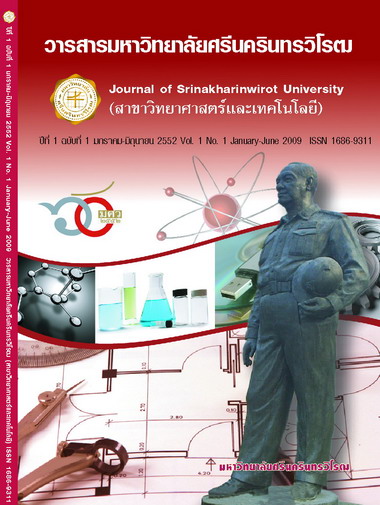การดูดซับสีในน้ำเสียจากโรงงานฟอกย้อมด้วยตะกอนจุลินทรีย์ (ADSORPTION OF DYES IN TEXTILE WASTEWATER BY BIOLOGICAL SLUDGE)
Keywords:
Adsorption, Bio-sludge, Reactive dye, Wastewater, Treatment of textile dyAbstract
บทคัดย่อวิธีการบำบัดน้ำเสียที่มักนิยมนำมาใช้อย่างแพร่หลายในปัจจุบันคือกระบวนการดูดซับทางกายภาพและเคมี แต่กระบวนการดังกล่าวข้างต้นยังมีข้อจำกัดมากมาย การเลือกใช้ตะกอนจุลินทรีย์ในการมาดูดซับ ทั้งสารอินทรีย์และสีย้อมจึงเป็นอีกทางเลือกหนึ่งที่สามารถแก้ไขปัญหาได้ ดังนั้นงานวิจัยนี้จะทำการศึกษาความสามารถในการดูดซับสีของตะกอนจุลินทรีย์จากระบบบำบัดน้ำเสีย ระยะเวลาสัมผัส ผลของพีเอชที่มีผลต่อการดูดซับ และสารละลายที่เหมาะสมในการชะล้างสีย้อมออกจากตะกอนจุลินทรีย์
ผลการศึกษาพบว่า ความสามารถในการดูดซับสีของตะกอนจุลินทรีย์ที่มีชีวิตกับตะกอนจุลินทรีย์ที่ไม่มีชีวิตมีความแตกต่างกัน ตะกอนจุลินทรีย์ที่มีชีวิตมีความสามารถในการดูดซับสีได้สูงกว่าตะกอนจุลินทรีย์ที่ตายแล้ว และยังพบอีกว่าตะกอนจุลินทรีย์ที่นำมาจากโรงบำบัดน้ำเสียรวมสี่พระยามีความสามารถในการดูดซับสีได้มากกว่าตะกอนจุลินทรีย์ที่มาจากโรงงานฟอกย้อม สำหรับตะกอนจุลินทรีย์ที่มาจากโรงบำบัดน้ำเสียรวมสี่พระยาจะใช้ระยะเวลาสัมผัส 6 ชั่วโมง ในขณะที่ตะกอนจุลินทรีย์จากโรงงานฟอกย้อมใช้ระยะเวลาสัมผัสเพียง 3 ชั่วโมง ความสามารถในการดูดซับที่มากที่สุดเท่ากับ 6.12 มิลลิกรัมต่อกรัม-เซลล์ โดยที่สภาวะความเป็นกรด-ด่างที่เหมาะสมกับตะกอนจุลินทรีย์ที่มีชีวิตเท่ากับ 7 ในขณะที่ตะกอนจุลินทรีย์ที่ไม่มีชีวิตจะพบว่าที่สภาวะความเป็นกรด-ด่างเพิ่มขึ้น ความสามารถในการดูดซับจะต่ำลง และ 0.1% SDS มีประสิทธิภาพในการชะล้างตะกอนได้ดีที่สุด
นอกจากนี้ยังได้มีการศึกษาผลของพีเอชต่อความสามารถในการดูดซับสีของตะกอนจุลินทรีย์ พบว่าตะกอนจุลินทรีย์ที่มีชีวิตจะแสดงความสามารถในการดูดซับสีสูงสุดที่ค่าความเป็นกรด-ด่างเท่ากับ 7 สำหรับตะกอนจุลินทรีย์ที่ไม่มีชีวิตจะให้ประสิทธิภาพการดูดซับที่ดีที่ค่าความเป็นกรด-ด่างเท่ากับ 3 Abstract
Nowadays, the popular color removal system is the chemical and physical adsorption processes, but the above treatment processes still had some limitations. The dye adsorption by bio-sludge from biological wastewater treatment system was the one of alternative system that might be suitable and could solve the problems above. Then, this research was consisted of the determination of dye adsorption yield of bio-sludge of biological wastewater treatment system, effect of reaction time for dye adsorption, effect of pH on the dye adsorption and the suitale eluent for elution of the dye from the dye adsorpted bio-sludge.
The results showed that the capacity of dyes adsorption between the living and dead bio-sludge was different. Dyes adsorption capacity of living bio-sludges were higher than that of dead bio-sludge, showed higher dye adsorption yield than that of the dead bio-sludge. Also, the bio-slduge from domestic wastewater treatment plant (Sriphaya central wastewater treatment plant) showed higher dye adsorption yield than that of bio-sludge from textile wastewter treatment plant. For the determination of optimal reaction time on the dye adsorption, it was found that the the bio-sludge of Sriphaya central wastewater treatment plant required about 6 hours for dye adsorption while bio-sludge of textile wastewater treatment plant required only 3 hours. The highest adsorption yield of 6.12 mg/L was found in living bio-sludge under pH of 7.0 while the dead bio-sludge showed high adsorption yield under pH of higher than 7.0. Also, the 0.1% SDS showed the highest elution ability.
The determination of optimal pH for the maximal dye adsorption of bio-sludge was also determined. It was found that the living bio-sludge showed that highest dye adsorption yield at the pH of 7. While the dead bio-sludge showed the highest dye adsorption yield at the pH of 3.
Downloads
Downloads
Published
How to Cite
Issue
Section
License
Srinakharinwirot University Journal of Sciences and Technology is licensed Under a Creative Commons Attribution-NonCommercial-NoDerivs 4.0 International (CC-BY-NC-ND 4.0) License, Unless Otherwise Stated. Please Read Journal Policies Page for More Information on Open Access, Copyright and Permissions.


